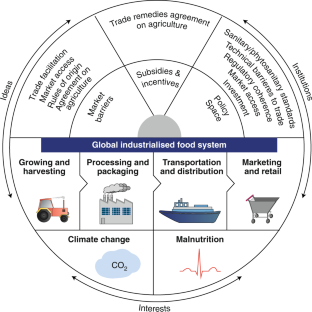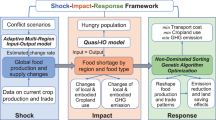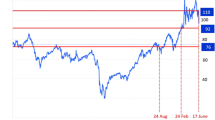The nexus between international trade, food systems, malnutrition and climate change
Trade agreements are a major determinant of the operation of food systems. Here, we examine how different aspects of trade can constrain or enable governments’ ability to implement food system-level actions aimed at enhancing nutrition and mitigating climate change. Concerning technical aspects, we focus on the potential impact of trade agreements on three major strategies for transforming food systems—namely the removal of market barriers for agricultural commodities, the protection of regulatory policy space and the revision of subsidies. Concerning non-technical aspects, we review the evidence on the political economy of trade to show that coherence between trade-policy goals and public-interest goals, such as nutrition and climate change, involves actors’ interests, ideas, and formal and informal institutional processes at various levels. With international agreements to liberalize trade and investment being binding, and recommendations to address malnutrition and climate change being non-binding, there is potential for trade to hinder efforts against malnutrition and climate change. Tempering this will require a deeper understanding of the complex trade–food system––nutrition–climate nexus and a new regulatory framework consistent with such complexity, as well as strategic stakeholder engagement.
This is a preview of subscription content, access via your institution
Access options
Access Nature and 54 other Nature Portfolio journals
Get Nature+, our best-value online-access subscription
cancel any time
Subscribe to this journal
Receive 12 digital issues and online access to articles
133,45 € per year
only 11,12 € per issue
Buy this article
- Purchase on SpringerLink
- Instant access to full article PDF
Prices may be subject to local taxes which are calculated during checkout

Similar content being viewed by others

International cooperation was key to stabilize wheat prices after the Russian Invasion of Ukraine
Article Open access 03 September 2024

Global environmental impacts of food system from regional shock: Russia-Ukraine war as an example
Article Open access 31 January 2024

The Russia-Ukraine war decreases food affordability but could reduce global greenhouse gas emissions
Article Open access 30 January 2024
References
- McCullough, E. B., Pingali, P. L. & Stamoulis, K. G. The transformation of agri-food systems: globalization, supply chains and smallholder farmers (FAO & Earthscan, 2008).
- Labonté, R. & Schrecker, T. in Globalization and health: pathways, evidence and policy (eds Labonté, R. et al.) Ch. 1 (Routledge, 2009).
- WTO. Understanding the WTO: The Agreementshttp://www.wto.org/english/thewto_e/whatis_e/tif_e/agrm1_e.htm (2014).
- De Schutter, O. International trade in agriculture and the right to food (FES, 2009).
- Auboin, M. et al. World Trade Report 2013: Factors shaping the future of world trade (eds Martin, A. & Hancock, J.) (WTO, 2013).
- Baldwin, R. 21st century regionalism: Filling the gap between 21st century and 20th century trade rules Policy Insights 2011 No. 56 (Centre for Economic Policy Research Geneva, 2011).
- Rodrik, D. What do trade agreements really do? J. Econ. Persp.32, 73–90 (2018). Google Scholar
- Friel, S., Hattersley, L. & Townsend, R. Trade policy and public health. Annu. Rev. Pub. Health36, 325–344 (2015). Google Scholar
- Mayer, J. Policy space: what, for what, and where? Dev. Pol. Rev.27, 373–395 (2009). Google Scholar
- Thow, A. M. et al. Will the next generation of preferential trade and investment agreements undermine prevention of noncommunicable diseases? A prospective policy analysis of the trans Pacific partnership agreement. Health Pol.119, 88–96 (2015). Google Scholar
- Labonte, R. Globalization, health, and the free trade regime: assessing the links. Persp. Glob. Dev. Technol.3, 47–72 (2004). Google Scholar
- Thow, A. M. Trade liberalisation and the nutrition transition: mapping the pathways for public health nutritionists. Pub. Health Nutr.12, 2150–2158 (2009). Google Scholar
- Legge, D., Gleeson, D. & Snowdon, W. Trade agreements and non-communicable diseases in the Pacific islands (WHO, 2011).
- Friel, S. et al. A new generation of trade policy: potential risks to diet-related health from the Trans Pacific Partnership agreement. Glob. Health9, 46 (2013). Google Scholar
- Friel, S. et al. Monitoring the impacts of trade agreements on food environments. Obesity Rev.14, 120–134 (2013). Google Scholar
- Schram, A. et al. A conceptual framework for investigating the impacts of international trade and investment agreements on noncommunicable disease risk factors. Health Pol. Plan.33, 123–136 (2017). Google Scholar
- Barlow, P., McKee, M., Basu, S. & Stuckler, D. The health impact of trade and investment agreements: a quantitative systematic review and network co-citation analysis. Glob. Health13, 13 (2017). Google Scholar
- Burns, D. K., Jones, A. P. & Suhrcke, M. The relationship between international trade and non-nutritional health outcomes: a systematic review of quantitative studies. Soc. Sci. Med.152, 9–17 (2016). PubMedGoogle Scholar
- Cowling, K., Thow, A. M. & Porter, K. P. Analyzing the impacts of global trade and investment on non-communicable diseases and risk factors: a critical review of methodological approaches used in quantitative analyses. Glob. Health14, 53 (2018). Google Scholar
- García-Dorado, S. C., Cornselsen, L., Smith, R. & Walls, H. Economic globalization, nutrition and health: a review of quantitative evidence. Glob. Health15, 15 (2019). Google Scholar
- Walls, H., Smith, R., Cuevas, S. & Hanefeld, J. International trade and investment: still the foundation for tackling nutrition related non-communicable diseases in the era of Trump? BMJ365, l2217 (2019). PubMedPubMed CentralGoogle Scholar
- Baker, P., Kay, A. & Walls, H. Trade and investment liberalization and Asia’s noncommunicable disease epidemic: a synthesis of data and existing literature. Glob. Health10, 66 (2014). Google Scholar
- Swinburn, B. A. et al. The global syndemic of obesity, undernutrition, and climate change: The Lancet Commission report. Lancet393, 791–846 (2019). PubMedGoogle Scholar
- Willett, W. et al. Food in the Anthropocene: the EAT–Lancet Commission on healthy diets from sustainable food systems. Lancet393, 447–492 (2019). Google Scholar
- Jha, S. & Srinivasan, P. V. Food inventory policies under liberalized trade. Int. J. Prod. Econ.71, 21–29 (2001). Google Scholar
- Santos‐Paulino, A. & Thirlwall, A. P. The impact of trade liberalisation on exports, imports and the balance of payments of developing countries. Econ. J.114, F50–F72 (2004). Google Scholar
- Cadot, O., De Melo, J., Estevadeordal, A., Suwa-Eisenmann, A. & Tumurchudur, B. Assessing the effect of NAFTA’s rules of origin (World Bank, 2002).
- Wilson, J. S., Mann, C. L. & Otsuki, T. Assessing the benefits of trade facilitation: a global perspective. World Econ.28, 841–871 (2005). Google Scholar
- McCorriston, S. H., Lamontagne-Godwin, J. D. Osborn, J., Parr, M. J. & Roberts, P. D. What is the evidence of the impact of agricultural trade liberalisation on food security in developing countries? A systematic review. (University of London, UK Government, 2013).
- Schram, A. et al. The role of trade and investment liberalization in the sugar-sweetened carbonated beverages market: a natural experiment contrasting Vietnam and the Philippines. Glob. Health11, 41 (2015). Google Scholar
- Barlow, P., McKee, M., Basu, S. & Stuckler, D. Impact of the North American Free Trade Agreement on high-fructose corn syrup supply in Canada: a natural experiment using synthetic control methods. CMAJ189, E881–E887 (2017). PubMedPubMed CentralGoogle Scholar
- Chatterjee, S., Rae, A. & Ray, R. in Globalisation, agriculture and development: perspectives from the Asia-Pacific (eds Tonts, M. & Siddique, M. A. B.) Ch. 6 (Cambridge Univ. Press, 2011).
- Hawkes, C. Promoting healthy diets and tackling obesity and diet-related chronic diseases: what are the agricultural policy levers? Food Nutr. Bulletin28, S312–S322 (2007). ADSGoogle Scholar
- Hawkes, C. in Trade, food, diet and health: perspectives and policy options (eds Hawkes, C. et al.) Ch. 3 (Wiley, 2010).
- Thow, A. M. & Hawkes, C. The implications of trade liberalization for diet and health: a case study from Central America. Glob. Health5, 5 (2009). Google Scholar
- Thow, A. M. & Snowdon, W. in Trade, food, diet and health: Perspectives and policy options (eds Hawkes, C. et al.) Ch. 9 (2010).
- Friel, S. et al. Shaping the discourse: what has the food industry been lobbying for in the Trans Pacific Partnership trade agreement and what are the implications for dietary health? Crit. Pub. Health26, 518–529 (2016). Google Scholar
- Wilkinson, J. The globalization of agribusiness and developing world food systems. Monthly Rev.61, 38 (2009). Google Scholar
- Public Citizen’s Global Trade Watch. Only one of 44 attempts to Use the GATT Article XX/GATS Article XIV ‘General Exception’ Has Ever Succeeded: Replicating the WTO Exception Construct Will Not Provide for an Effective TPP General Exception. Public Citizenhttps://go.nature.com/2P6h3A9 (2015).
- Goldstein, B. D. The precautionary principle also applies to public health actions. Am. J. Public Health91, 1358–1361 (2001). CASPubMedPubMed CentralGoogle Scholar
- Scott, J. The WTO Agreement on Sanitary and Phytosanitary Measures (Oxford Univ. Press, 2009).
- Stoler, A. L. in Preferential Trade Agreement Policies for Development (eds Maur, C. & Chauffour, J.-P.) 217–233 (World Bank Publications, 2011).
- Thow, A. M., Jones, A., Hawkes, C., Ali, I. & Labonté, R. Nutrition labelling is a trade policy issue: lessons from an analysis of specific trade concerns at the World Trade Organization. Health Prom. Int.33, 561–571 (2017). Google Scholar
- Labonte, R., Schram, A. & Ruckert, A. The Trans-Pacific Partnership: is it everything we feared for health? Int. J. Health Pol. Manag.5, 487–496 (2016). Google Scholar
- Schram, A., Friel, S., Anthony VanDuzer, J., Ruckert, A. & Labonté, R. Internalisation of international investment agreements in public policymaking: developing a conceptual framework of regulatory chill. Global Pol.9, 193–202 (2018). Google Scholar
- Van Harten, G. Sovereign Choices and Sovereign Constraints: Judicial Restraint in Investment Treaty Arbitration (Oxford Univ. Press, 2013).
- Public Citizen’s Global Trade Watch. Case studies: investor-state attacks on public interest policies. Public Citizenhttps://go.nature.com/34Rdfti (2016).
- DFAT. Peru–Australia Free Trade Agreement (Australian Government, 2018).
- Gerasimchuk, I., Bridle, R., Beaton, C. & Charles, C. State of Play on Biofuel Subsidies: Are policies ready to shift? (The International Institute for Sustainable Development, 2012).
- Charles, C. et al. Biofuels—At What Cost? A review of costs and benefits of EU biofuel policies (International Institute for Sustainable Development, 2013).
- Harmer, T. Biofuels subsidies and the law of the WTO (International Centre for Trade and Sustainable Development, 2009).
- Hall, P. in Comparative politics: Rationality, culture, and structure (eds Lichbach, M. I. & Zuckerman, A. S.) 174–207 (Cambridge Univ. Press, 1997).
- Townsend, B., Schram, A., Baum, F., Labonté, R. & Friel, S. How does policy framing enable or constrain inclusion of social determinants of health and health equity on trade policy agendas? Crit. Public Healthhttps://doi.org/10.1080/09581596.2018.1509059 (2018). Google Scholar
- Baker, P. et al. What enables and constrains the inclusion of the social determinants of health inequities in government policy agendas? A narrative review. Int. J. Health Pol. Manag.7, 101–111 (2017). Google Scholar
- Tanner, T. & Allouche, J. Towards a new political economy of climate change and development. IDS Bulletin42, 1–14 (2011). Google Scholar
- Margulis, M. E. Trading out of the global food crisis? The World Trade Organization and the geopolitics of food security. Geopolitics19, 322–350 (2014). Google Scholar
- Cottier, T. & Payosova, T. in Research Handbook on Climate Change and Trade Law (ed. Delimatsis, P.) Ch. 1 (Edward Elgar Publishing, 2016).
- Farsund, A. A., Daugbjerg, C. & Langhelle Food security and trade: reconciling discourses in the Food and Agriculture Organization and the World Trade Organization. Food Security7, 383–391 (2015). Google Scholar
- Clapp, J. Food Security and contested agricultural trade norms. J. Int. Law Int. Relat.11, 104–115 (2015). Google Scholar
- Margulis, M. E. The World Trade Organization between law and politics: negotiating a solution for public stockholding for food security purposes. Transnat. Legal Theory9, 343–360 (2018). Google Scholar
- Battams, S. & Townsend, B. Power asymmetries, policy incoherence and noncommunicable disease control. Crit. Public Healthhttps://doi.org/10.1080/09581596.2018.1492093 (2018). Google Scholar
- Schram, A. When evidence isn’t enough: ideological, institutional and interest-based constraints on achieving trade and health policy coherence. Glob. Soc. Pol.18, 62–80 (2017). Google Scholar
- Van Asselt, H. The fragmentation of global climate governance: consequences and management of regime interactions (Edward Elgar Publishing, 2014).
- Benford, R. D. & Snow, D. A. Framing processes and social movements: an overview and assessment. Ann. Rev. Sociol.26, 611–639 (2000). Google Scholar
- Finnemore, M. & Sikkink, K. International norm dynamics and political change. Int. Organization52, 897 (1998). Google Scholar
- Townsend, B., Schram, A., Baum, F., Labonte, R. & Friel, S. How does policy framing enable or constrain inclusion of social determinants of health and health equity on trade policy agendas? Crit. Public Healthhttps://doi.org/10.1080/09581596.2018.1509059 (2018). Google Scholar
- Baker, P., Friel, S., Gleeson, D., Thow, A. & Labonte, R. Trade and nutrition policy coherence: A framing analysis and Australian case study. Pub. Health Nutrition22, 2329–2337 (2019). Google Scholar
- Friel, S. et al. Shaping the discourse: what has the food industry been lobbying for in the Trans Pacific Partnership trade agreement and what are the implications for dietary health? Crit. Public Health26, 518–529 (2016). Google Scholar
- Lencucha, R. & Thow, A. M. How neoliberalism is shaping the supply of unhealthy commodities and what this means for NCD prevention. Int. J. Health Pol. Manag.8, 514–520 (2019). Google Scholar
- Braithwaite, J. & Drahos, P. Global Business Regulation (Cambridge Univ. Press, 2000).
- Clapp, J. & Scrinis, G. Big Food, nutritionism, and corporate power. Globalizations14, 578–595 (2017). Google Scholar
- Clapp, J. The trade-ification of the food sustainability agenda. J. Peasant Studies44, 335–353 (2016). Google Scholar
- Clapp, J., Newell, P. & Brent, Z. W. The global political economy of climate change, agriculture and food systems. J. Peasant Studies45, 80–88 (2018). Google Scholar
- Lee, R. P. The politics of international agri-food policy: discourses of trade-oriented food security and food sovereignty. Environ. Politics22, 216–234 (2013). Google Scholar
- Burnett, K. & Murphy, S. What place for international trade in food sovereignty? J. Peasant Studies41, 1065–1084 (2014). Google Scholar
- Jarman, H. Trade policy governance: what health policymakers and advocates need to know. Health Policy121, 1105–1112 (2017). PubMedGoogle Scholar
- Friel, S. et al. An exposé of the realpolitik of trade negotiations: implications for population nutrition. Pub. Health Nutrition22, 3038–3091 (2019). Google Scholar
- Walls, H., Smith, R. D. & Drahos, P. Improving regulatory capacity to manage risks associated with trade agreements. Glob. Health11, 14 (2015). Google Scholar
- Transforming Our World: The 2030 Agenda for Sustainable Development A/RES/70/1 (United Nations, 2015).
- United Nations Decade of Action on Nutrition 2016–2025 Work Programme (WHO & FAO, 2017).
- Feldbaum, H., Lee, K. & Michaud, J. Global Health and Foreign Policy. Epidemiol. Rev.32, 82–92 (2010). PubMedPubMed CentralGoogle Scholar
- Macgregor-Bowles, I. & Bowles, D. C. Trump, Brexit, right-wing anti-globalisation, and an uncertain future for public health. AIMS Public Health4, 139–148 (2017). PubMedPubMed CentralGoogle Scholar
- Thow, A. M. & Nisbett, N. Trade, nutrition, and sustainable food systems. Lancet394, 716–718 (2019). PubMedGoogle Scholar
- Hawkes, C. Enhancing coherence between trade policy and nutrition action: implementing the framework for action of the second international conference on nutrition. (United Nations Standing Committee on Nutrition, 2015).
- Thaiprayoon, S. & Smith, R. Capacity building for global health diplomacy: Thailand’s experience of trade and health. Health Pol. Plan.30, 1118–1128 (2015). Google Scholar
- Thow, A., Annan, R., Mensah, L. & Chowdhury, S. N. Development, implementation and outcome of standards to restrict fatty meat in the food supply and prevent NCDs: learning from an innovative trade/food policy in Ghana. BMC Public Health14, 249 (2014). PubMedPubMed CentralGoogle Scholar
Author information
Authors and Affiliations
- Menzies Centre for Health Governance, School of Regulation and Global Governance, The Australian National University, Canberra, Australian Capital Territory, Australia Sharon Friel, Ashley Schram & Belinda Townsend
- Sharon Friel





